 | –≠–ª–µ–∫—Ç—Ä–æ–Ω–Ω—ã–π –∫–æ–º–ø–æ–Ω–µ–Ω—Ç: LM4651 | –°–∫–∞—á–∞—Ç—å:  PDF PDF  ZIP ZIP |
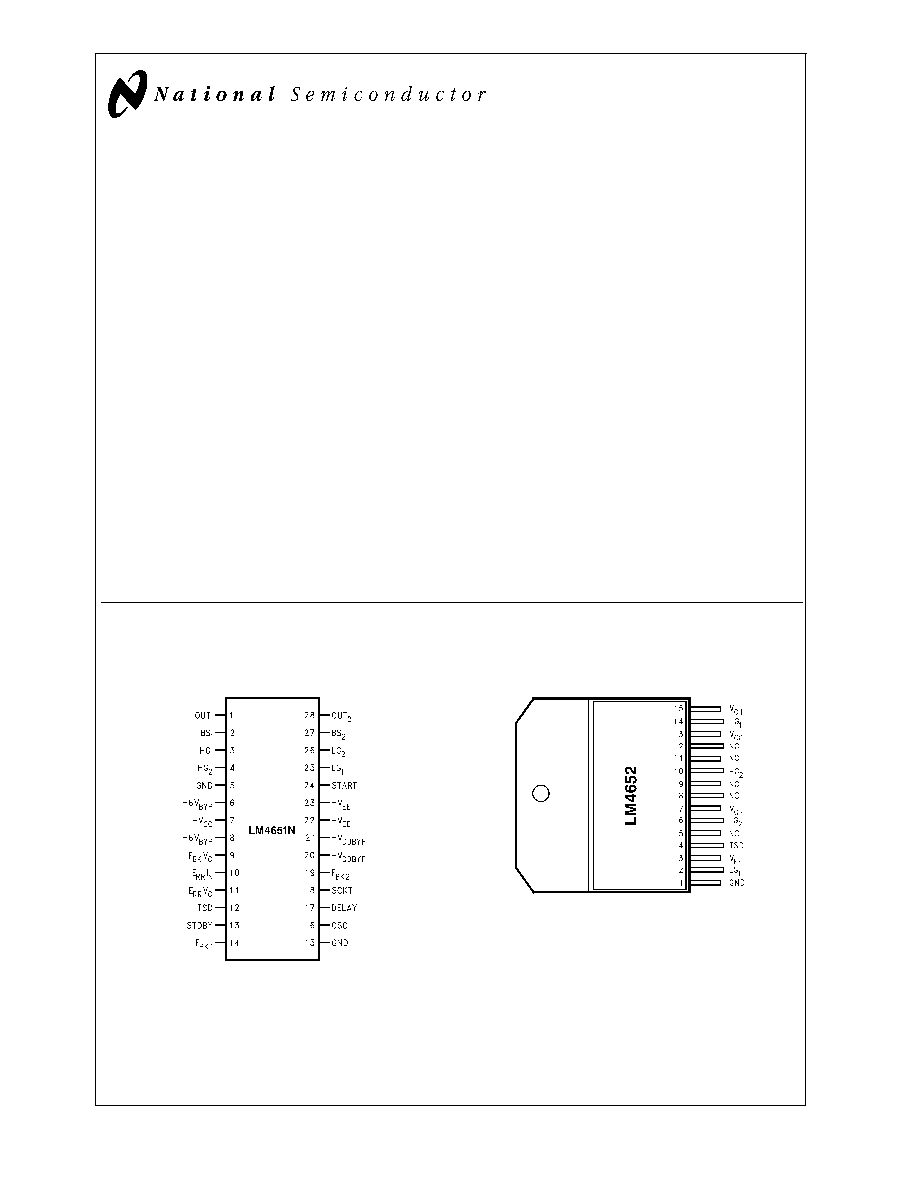
LM4651 & LM4652
Overture
TM
Audio Power Amplifier
170W Class D Audio Power Amplifier Solution
General Description
The IC combination of the LM4651 driver and the LM4652
power MOSFET provides a high efficiency, Class D sub-
woofer amplifier solution.
The LM4651 is a fully integrated conventional pulse width
modulator driver IC. The IC contains short circuit, under
voltage, over modulation, and thermal shut down protection
circuitry. It contains a standby function, which shuts down
the pulse width modulation and minimizes supply current.
The LM4652 is a fully integrated H-bridge power MOSFET
IC in a TO-220 power package. Together, these two IC's
form a simple, compact high power audio amplifier solution
complete with protection normally seen only in Class AB
amplifiers. Few external components and minimal traces
between the IC's keep the PCB area small and aids in EMI
control.
The near rail-to-rail switching amplifier substantially in-
creases the efficiency compared to Class AB amplifiers. This
high efficiency solution significantly reduces the heat sink
size compared to a Class AB IC of the same power level.
This two-chip solution is optimum for powered subwoofers
and self powered speakers.
Key Specifications
n
Output power into 4
with
<
10% THD.
170W (Typ)
n
THD at 10W, 4
, 10 - 500Hz.
<
0.3% THD (Typ)
n
Maximum efficiency at 125W
85% (Typ)
n
Standby attenuation.
>
100dB (Min)
Features
n
Conventional pulse width modulation.
n
Externally controllable switching frequency.
n
50kHZ to 200kHz switching frequency range.
n
Integrated error amp and feedback amp.
n
Turn-on soft start and under voltage lockout.
n
Over modulation protection (soft clipping).
n
Short circuit current limiting and thermal shutdown
protection.
n
15 Lead TO-220 isolated package.
n
Self checking protection diagnostic.
Applications
n
Powered subwoofers for home theater and PC's
n
Car booster amplifier
n
Self-powered speakers
Connection Diagrams
Overture
Æ
is a registered trademark of National Semiconductor Corporation.
LM4651 Plastic Package
DS101277-72
Top View
Order Number LM4651N
See NS Package Number N28B
LM4652 Plastic Package (Note 8)
DS101277-73
Isolated TO-220 Package
Order Number LM4652TF
See NS Package Number TF15B
or
Non-Isolated TO-220 Package
Order Number LM4652TA
See NS Package Number TA15A
August 2000
LM4651
&
LM4652
Overture
TM
170W
Class
D
Audio
Power
Amplifier
Solution
© 2001 National Semiconductor Corporation
DS101277
www.national.com
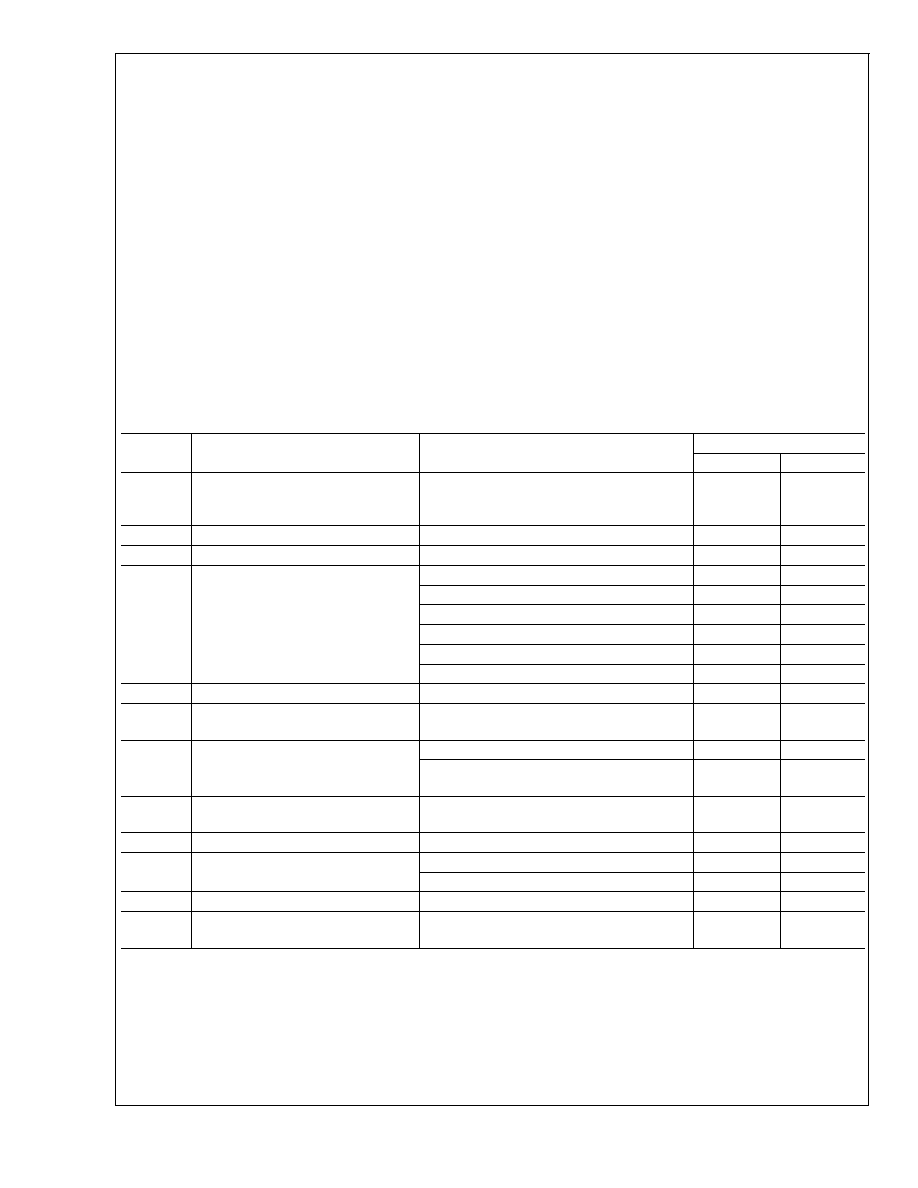
Absolute Maximum Ratings
(Notes 1, 2)
If Military/Aerospace specified devices are required,
please contact the National Semiconductor Sales Office/
Distributors for availability and specifications.
Supply Voltage
±
22V
Output Current (LM4652)
10A
Power Dissipation (LM4651) (Note 3)
1.5W
Power Dissipation (LM4652) (Note 3)
32W
ESD Susceptibility (LM4651) (Note 4)
2000V
LM4652 (pins 2,6,10,11)
500V
ESD Susceptibility (LM4651) (Note 5)
200V
LM4652 (pins 2,6,10,11)
100V
Junction Temperature (Note 6)
150∞C
Soldering Information
N, TA and TF Package (10 seconds)
260∞C
Storage Temperature
-40∞C to + 150∞C
Operating Ratings
(Notes 1, 2)
Temperature Range
-40∞C
T
A
+85∞C
Supply Voltage |V
+
| + |V
-
|
22V to 44V
Thermal Resistance
LM4651 N Package
JA
52∞C/W
JC
22∞C/W
LM4652 TF, TO-220 Package
JA
43∞C/W
JC
2.0∞C/W
LM4652 T, TO-220 Package
JA
37∞C/W
JC
1.0∞C/W
System Electrical Characteristics for LM4651 and LM4652
(Notes 1, 2)
The following specifications apply for +V
CC
= +20V, -V
EE
= -20V, f
SW
= 125kHz, f
IN
= 100Hz, R
L
= 4
, unless otherwise
specified. Typicals apply for T
A
= 25∞C. For specific circuit values, refer to Figure 1 (Typical Audio Application Circuit).
Symbol
Parameter
Conditions
LM4651 & LM4652
Typical
Units
I
CQ
Total Quiescent Power Supply
Current
V
CIN
= 0V, L
O
= 0mA, |I
VCC+
| + |I
VEE-
|
R
DLY
= 0
R
DLY
= 10k
237
124
mA
mA
I
STBY
Standby Current
V
PIN
13 = 5V, Stby: On
17
mA
A
M
Standby Attenuation
V
PIN
13 = 5V, Stby: On
>
115
dB
P
O
Output Power (Continuous Average)
R
L
= 4
, 1% THD
125
W
R
L
= 4
, 10% THD
155
W
R
L
= 8
, 1% THD
75
W
R
L
= 8
, 10% THD
90
W
f
SW
= 75kHz, R
L
= 4
, 1% THD
135
W
f
SW
= 75kHz, R
L
= 4
, 10% THD
170
W
Efficiency at P
O
= 5W
P
O
= 5W,
R
DLY
= 5k
55
%
Efficiency
(LM4651 & LM4652)
P
O
= 125W, THD = 1%
85
%
Pd
Power Dissipation
(LM4651 + LM4652)
P
O
= 125W, THD = 1% (max)
22
W
f
SW
= 75kHz, P
O
= 135W,
THD = 1% (max)
22
W
THD+N
Total Harmonic Distortion Plus Noise
10W, 10Hz
f
IN
500Hz, A
V
= 18 dB
10Hz
BW
80kHz
0.3
%
e
OUT
Output Noise
A Weighted, no signal, R
L
= 4
550
µV
SNR
Signal-to-Noise Ratio
A-Wtg, P
out
= 125W, R
L
4
92
dB
22kHz BW, P
out
= 125W, R
L
4
89
dB
V
OS
Output Offset Voltage
V
IN
= 0V, I
O
= 0mA, R
OFFSET
= 0
0.7
V
PSRR
Power Supply Rejection Ratio
R
L
= 4
, 10Hz
BW
30kHz
+V
CCAC
= -V
EEAC
= 1V
RMS
, f
AC
= 120Hz
37
dB
LM4651
&
LM4652
www.national.com
2
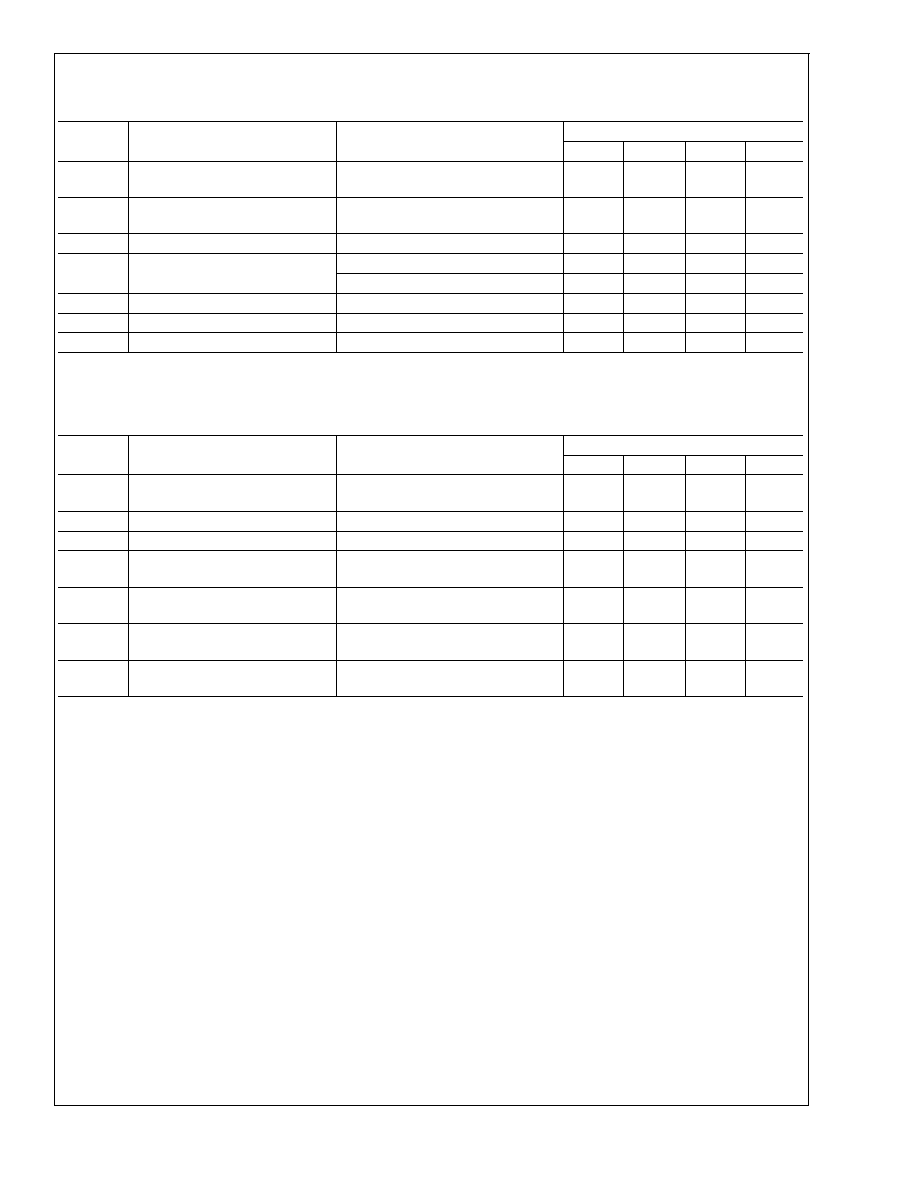
Electrical Characteristics for LM4651
(Notes 1, 2, 7)
The following specifications apply for +V
CC
= +20V, -V
EE
= -20V, f
SW
= 125kHz, unless otherwise specified. Limits apply for
T
A
= 25∞C. For specific circuit values, refer to Figure 1 (Typical Audio Application Circuit).
Symbol
Parameter
Conditions
LM4651
Min
Typical
Max
Units
I
CQ
Total Quiescent Current
LM4652 not connected, I
O
= 0mA,
|I
VCC+
| + |I
VEE-
|, R
DLY
= 0
15
36
45
mA
Standby
V
IL
Standby Low Input Voltage
Not in Standby Mode
0.8
V
V
IH
Standby High Input Voltage
In Standby Mode
2.5
2.0
V
f
SW
Switching Frequency Range
R
OSC
= 15k
65
kHz
R
OSC
= 0
200
kHz
f
SWerror
50% Duty Cycle Error
R
OSC
= 4k
, f
SW
= 125kHz
1
3
%
T
dead
Dead Time
R
DLY
= 0
27
ns
T
OverMod
Over Modulation Protection Time
Pulse Width Measured at 50%
310
ns
Electrical Characteristics for LM4652
(Notes 1, 2, 7)
The following specifications apply for +V
CC
= +20V, -V
EE
= -20V, unless otherwise specified. Limits apply for T
A
= 25∞C. For
specific circuit values, refer to Figure 1 (Typical Audio Application Circuit).
Symbol
Parameter
Conditions
LM4652
Min
Typical
Max
Units
V
(BR)
DSS
Drain-to-Source Breakdown
Voltage
VGS = 0
55
V
I
DSS
Drain-to-Source Leakage Current
VDS = 44V
DC
, VGS = 0V
1.0
mA
VGS
th
Gate Threshold Voltage
VDS = VGS, ID = 1mA
DC
0.85
V
R
DS(ON)
Static Drain-to-Source On
Resistance
VGS = 6V
DC
, ID = 6A
DC
200
300
m
t
r
Rise Time
VGD = 6V
DC
, VDS = 40V
DC
, R
GATE
= 0
25
ns
t
f
Fall Time
VGD = 6V
DC
, VDS = 40V
DC
, R
GATE
= 0
26
ns
I
D
Maximum Saturation Drain
Current
VGS = 6V
DC
, VDS = 10V
DC
8
10
A
DC
Note 1: Absolute Maximum Ratings indicate limits beyond which damage to the device may occur. Operating Ratings indicate conditions for which the device is
functional, but do not guarantee specific performance limits. Electrical Characteristics state DC and AC electrical specifications under particular test conditions which
guarantee specific performance limits. This assumes that the device is within the Operating Ratings. Specifications are not guaranteed for parameters where no limit
is given, however, the typical value is a good indication of device performance.
Note 2: All voltages are measured with respect to the GND pin unless otherwise specified.
Note 3: For operating at case temperatures above 25∞C, the LM4651 must be de-rated based on a 150∞C maximum junction temperature and a thermal resistance
of
JA
= 62 ∞C/W (junction to ambient), while the LM4652 must be de-rated based on a 150∞C maximum junction temperature and a thermal resistance of
JC
=
2.0 ∞C/W (junction to case) for the isolated package (TF) or a thermal resistance of
JC
= 1.0∞C/W (junction to case) for the non-isolated package (T).
Note 4: Human body model, 100 pF discharged through a 1.5 k
resistor.
Note 5: Machine Model, 220pF-240pF discharge through all pins.
Note 6: The operating junction temperature maximum, T
jmax
is 150∞C.
Note 7: Limits are guaranteed to National's AOQL (Average Outgoing Quality Level).
Note 8: The LM4652TA package TA15A is a non-isolated package, setting the tab of the device and the heat sink at -V potential when the LM4652 is directly
mounted to the heat sink using only thermal compound. If a mica washer is used in addition to thermal compound,
CS
(case to sink) is increased, but the heat sink
will be isolated from -V.
LM4651
&
LM4652
www.national.com
3
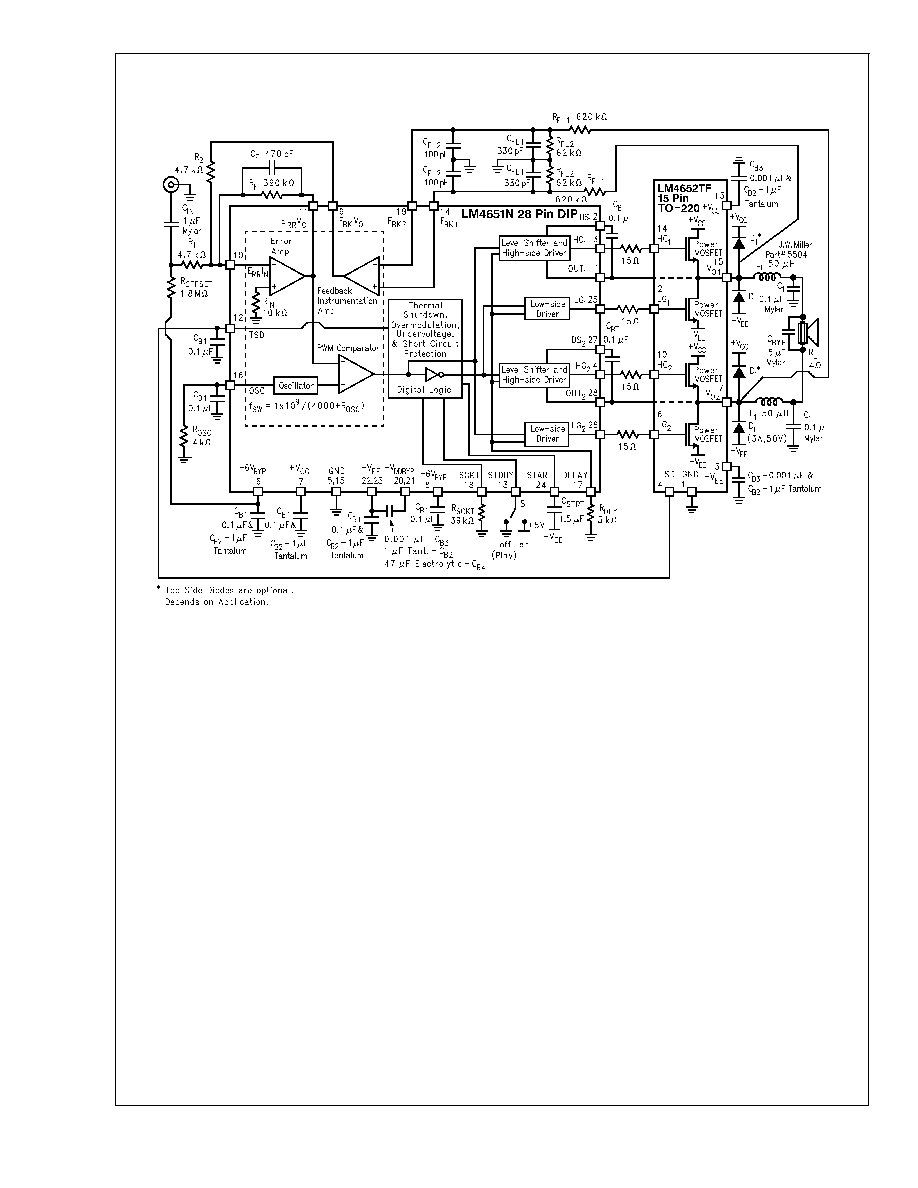
Electrical Characteristics for LM4652
(Notes 1, 2, 7) (Continued)
DS101277-68
FIGURE 1. Typical Application Circuit and Test Circuit
LM4651
&
LM4652
www.national.com
4
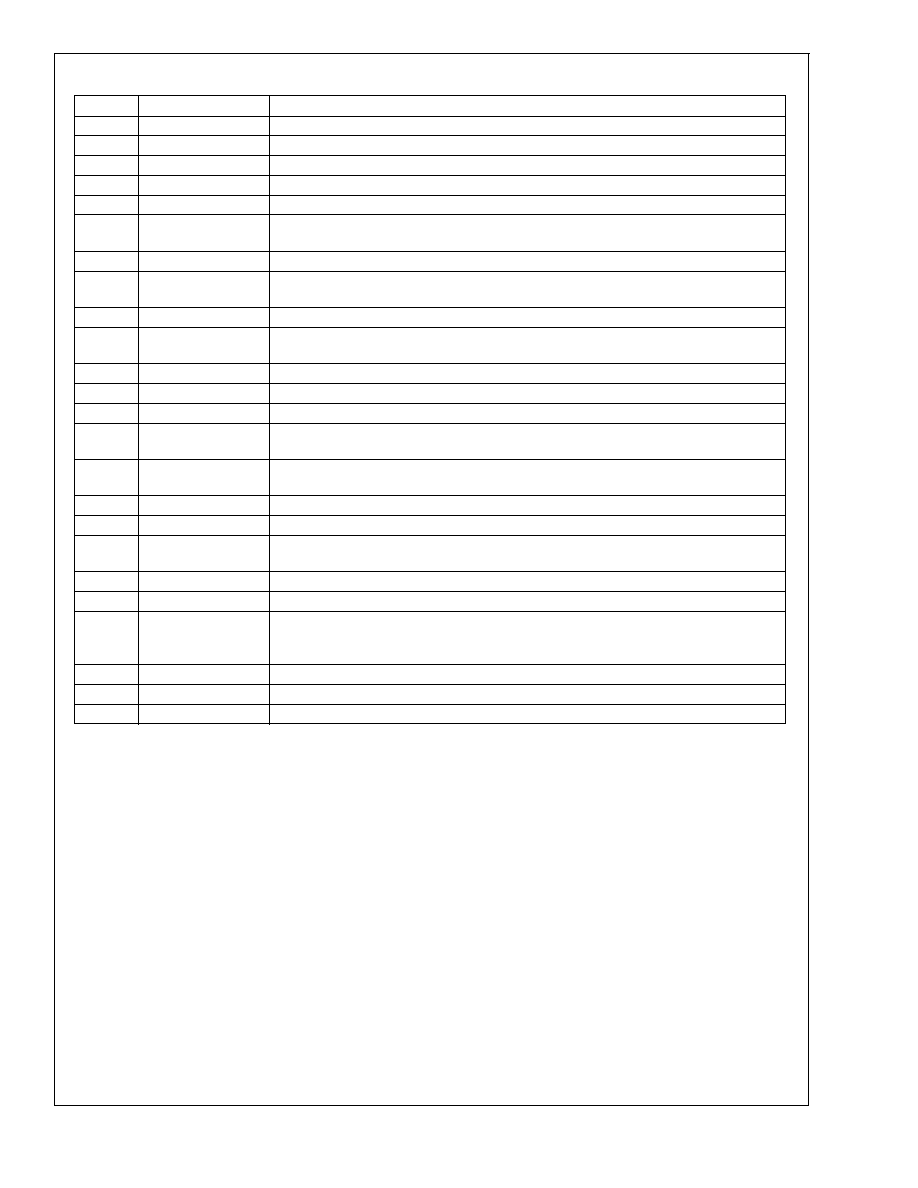
LM4651 Pin Descriptions
Pin No.
Symbol
Description
1
OUT
1
The reference pin of the power MOSFET output to the gate drive circuitry.
2,27
BS
1
,BS
2
The bootstrap pin provides extra bias to drive the upper gates, HG
1
,HG
2
.
3
HG
1
High-Gate #1 is the gate drive to a top side MOSFET in the H-Bridge.
4
HG
2
High-Gate #2 is the gate drive to a top side MOSFET in the H-Bridge.
5,15
GND
The ground pin for all analog circuitry.
6
+6V
BYP
The internally regulated positive voltage output for analog circuitry. This pin is available
for internal regulator bypassing only.
7
+V
CC
The positive supply input for the IC.
8
-6V
BYP
The internally regulated negative voltage output for analog circuitry. This pin is available
for internal regulator bypassing only.
9
F
BK
V
O
The feedback instrumentation amplifier output pin.
10
E
RR
I
N
The error amplifier inverting input pin. The input audio signal and the feedback signal are
summed at this input pin.
11
E
RR
V
O
The error amplifier output pin.
12
TSD
The thermal shut down input pin for the thermal shut down output of the LM4652.
13
STBY
Standby function input pin. This pin is CMOS compatible.
14
FBK
1
The feedback instrumentation amplifier pin. This must be connected to the feedback filter
from V
O1
(pin 15 on the LM4652 ).
16
OSC
The switching frequency oscillation pin. Adjusting the resistor from 15.5k
to 0
changes the switching frequency from 75kHz to 225kHz.
17
Delay
The dead time setting pin.
18
SCKT
Short circuit setting pin. Minimum setting is 10A.
19
FBK
2
The feedback instrumentation amplifier pin. This must be connected to the feedback filter
from V
O2
(pin 7 on the LM4652 ).
20,21
-V
DDBYP
The regulator output for digital blocks. This pin is for bypassing only.
22,23
-V
EE
The negative voltage supply pin for the IC.
24
START
The start up capacitor input pin. This capacitor adjusts the start up time of the diagnostic
sequence for the modulator. Refer to Start up Sequence and Timing in the
Application Information section.
25
LG
1
Low-Gate #1 is the gate drive to a bottom side MOSFET in the H-Bridge.
26
LG
2
Low-Gate #2 is the gate drive to a bottom side MOSFET in the H-Bridge.
28
OUT
2
The reference pin of the power MOSFET output to the gate drive circuitry.
LM4651
&
LM4652
www.national.com
5

LM4652 Pin Descriptions
Pin No.
Symbol
Description
1
GND
A ground reference for the thermal shut down circuitry.
2
LG
1
Low-Gate #1 is the gate input to a bottom side MOSFET in the H-Bridge.
3
-V
EE
The negative voltage supply input for the power MOSFET H-Bridge.
4
TSD
The thermal shut down flag pin. This pin transitions to 6V when the die temperature
exceeds 150∞C.
5
NC
No connection
6
LG
2
Low-Gate #2 is the gate input to a bottom side MOSFET in the H-Bridge.
7
VO
2
The switching output pin for one side of the H-Bridge.
8
NC
No connection.
9
NC
No connection.
10
HG
2
High-Gate #2 is the gate input to a top side MOSFET in the H-Bridge.
11
NC
No connection.
12
NC
No connection.
13
+V
CC
The positive voltage supply input for the power MOSFET H-Bridge.
14
HG
1
High-Gate #1 is the gate input to a top side MOSFET in the H-Bridge.
15
VO
2
The switching output pin for one side of the H-Bridge.
Note: NC, no connect pins are floating pins. It is best to connect the pins to GND to minimize any noise from being coupled into
the pins.
External Components Description
(Refer to Figure 1)
Components
Functional Description
1.
R
1
Works with R
2
, R
fl1
and R
fl2
to set the gain of the system. Gain = [(R
2
/ R
1
) x ((R
fl1
+
R
fl2
)/ R
fl2
) - (R
2
/ R
1
) + .5].
2.
R
2
See description above for R
1
.
3.
R
f
Sets the gain and bandwidth of the system by creating a low pass filter for the Error
Amplifier's feedback with C
f
. 3dB pole is at f
C
= 1/(2
R
f
C
f
) (Hz).
4.
C
f
See description above for R
f
.
5.
R
fI1
Provides a reduction in the feedback with R
fI2
. R
fI1
should be 10 X R
fI2
minimum to
reduce effects on the pole created by R
fI2
and C
fI1
. See also note for R
1
, R
2
for effect on
System Gain.
6.
R
fI2
R
fI2
and C
fI1
creates a low pass filter with a pole at f
C
= 1/(2
R
fI2
C
fI1
) (Hz). See also
note for R
1
, R
2
for effect on System Gain.
7.
C
fI1
See description above for R
fI2
.
8.
R
fI3
Establish the second pole for the low pass filter in the feedback path at f
C
=
1/(2
R
fI3
C
fI2
) (Hz).
9.
C
fI2
See description above for R
fI3
.
10.
L
1
Combined with C
BYP
creates a 2-pole, low pass output filter that has a -3dB pole at f
C
= 1/[2
(L
1
2C
BYP
)
1
/
2
] (Hz).
11.
C
1
Filters high frequency noise from the amplifier's output to ground. Recommended value
is 0.1µF to 1µF.
12.
C
byp
See description for L
1
.
13.
C
B1
-C
B4
Bypass capacitors for V
CC
, V
EE
, analog and digital voltages (V
DD
, +6V, -6V). See
Supply Bypassing and High Frequency PCB Design in the Application Information
section for more information.
14.
B
BT
Provides the bootstrap capacitance for the boot strap pin.
15.
R
DLY
Sets the dead time or break before make to T
DLY
= (1.7x10
-12
) (500 + R
DLY
) (seconds).
16.
C
START
Controls the startup time with T
START
= (8.5x10
4
) C
START
(seconds).
17.
R
SCKT
Sets the output short circuit current with I
SCKT
= (1x10
5
)/ (10k
\
R
SCKT
) (A).
18.
R
OSC
Controls the switching frequency with f
SW
= 1 X 10
9
/ (4000 + R
OSC
) (Hz).
19.
D
1
Schottky diode to protect the output MOSFETs from fly back voltages.
LM4651
&
LM4652
www.national.com
6
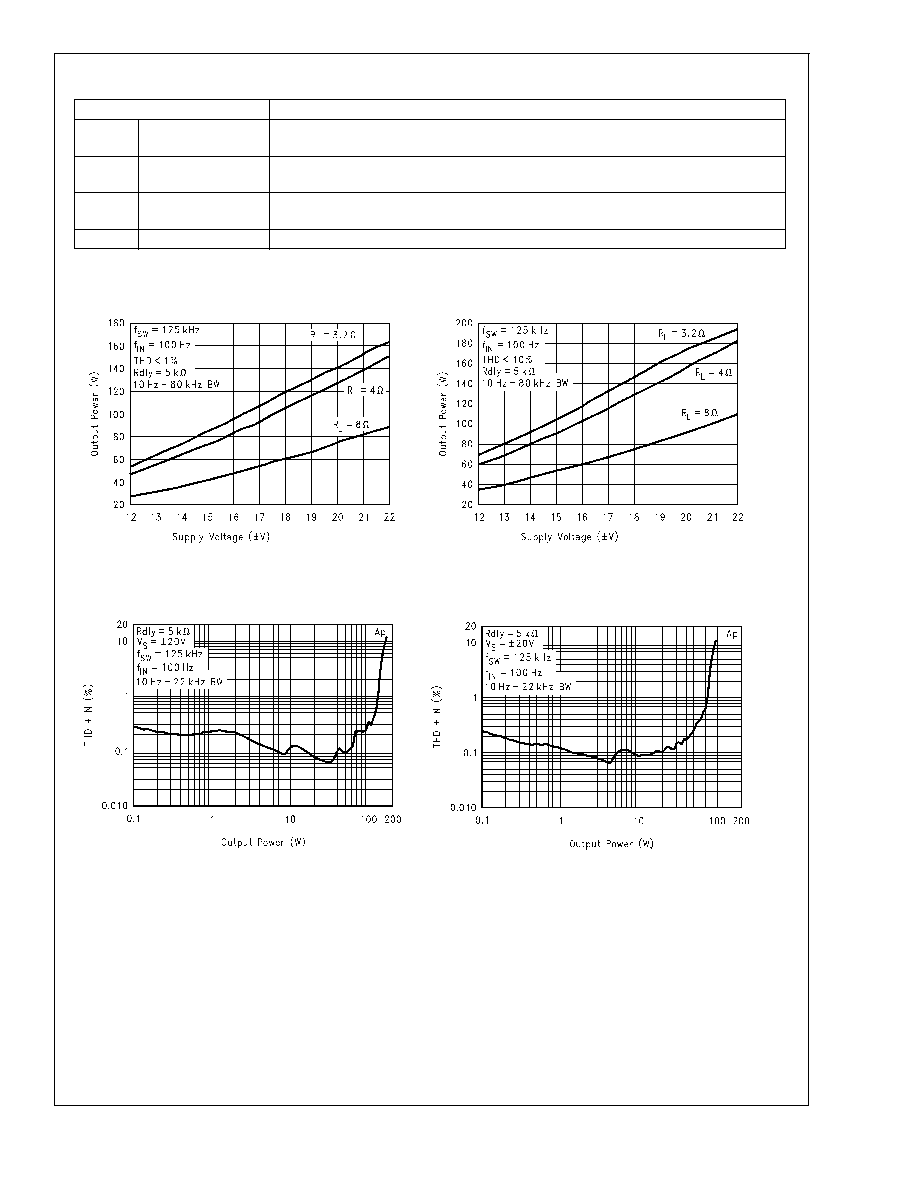
External Components Description
(Refer to Figure 1) (Continued)
Components
Functional Description
20.
C
SBY1
, C
SBY2
,
C
SBY3
Supply de-coupling capacitors. See Supply Bypassing in the Application Information
section.
21.
R
OFFSET
Provides a small DC voltage at the input to minimize the output DC offset seen by the
load. This also minimize power on pops and clicks.
22.
C
IN
Blocks DC voltages from being coupled into the input and blocks the DC voltage created
by R
OFFSET
from the source.
23.
R
gate
Slows the rise and fall time of the gate drive voltages that drive the output FET's.
Typical Performance Characteristics
Output Power vs. Supply Voltage
DS101277-4
Output Power vs. Supply Voltage
DS101277-5
THD+N vs. Output Power
R
L
= 4
DS101277-6
THD+N vs. Output Power
R
L
= 8
DS101277-7
LM4651
&
LM4652
www.national.com
7
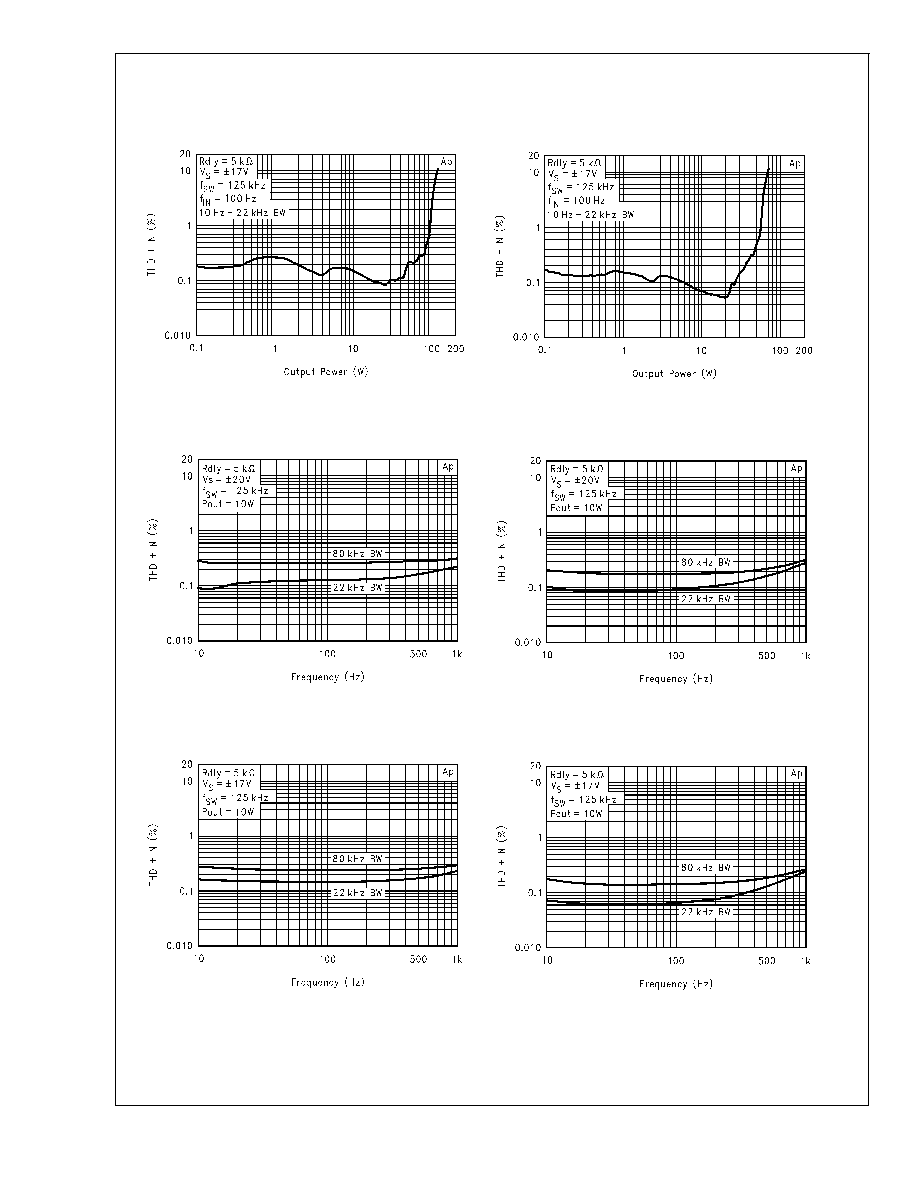
Typical Performance Characteristics
(Continued)
THD+N vs. Output Power
R
L
= 4
DS101277-8
THD+N vs. Output Power
R
L
= 8
DS101277-9
THD+N vs. Frequency vs. Bandwidth
R
L
= 4
DS101277-10
THD+N vs. Frequency vs. Bandwidth
R
L
= 8
DS101277-11
THD+N vs. Frequency vs. Bandwidth
R
L
= 4
DS101277-12
THD+N vs. Frequency vs. Bandwidth
R
L
= 8
DS101277-13
LM4651
&
LM4652
www.national.com
8
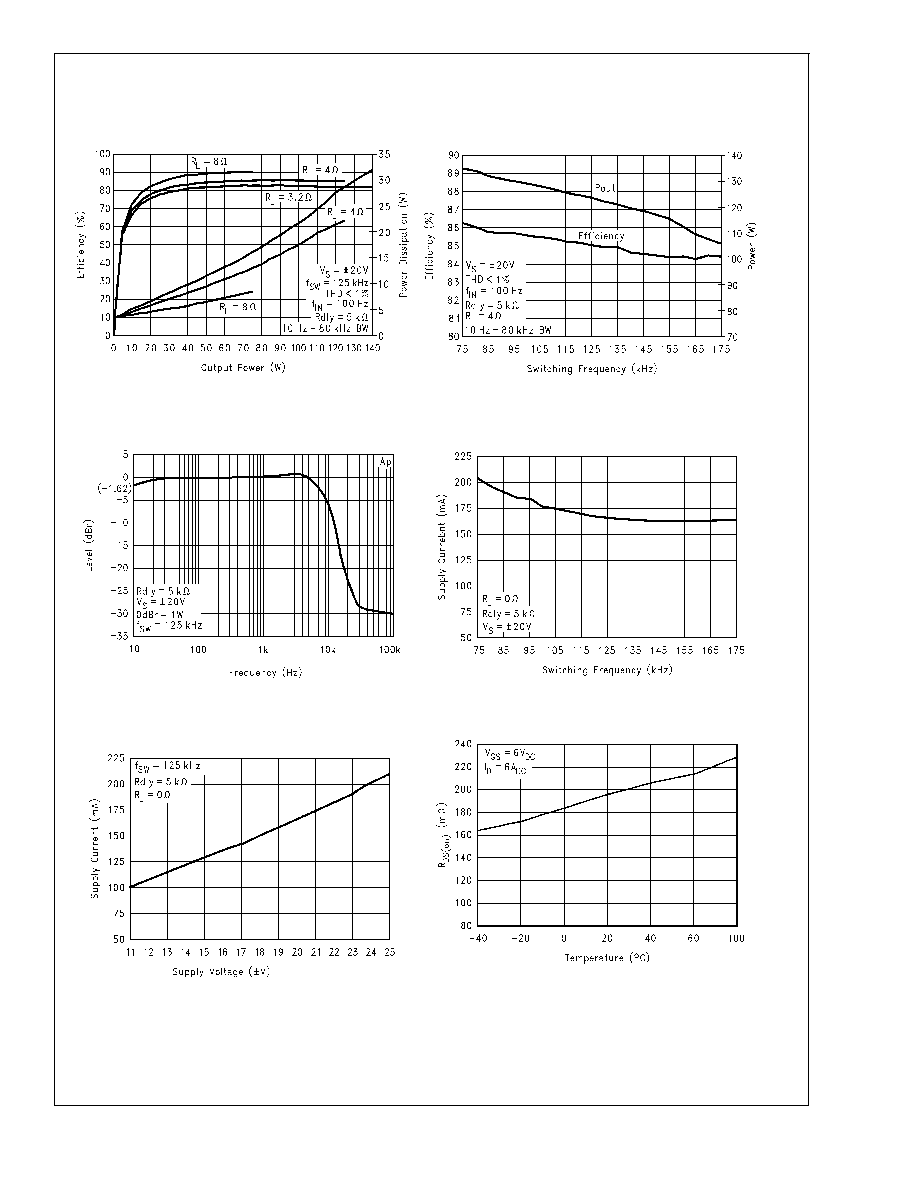
Typical Performance Characteristics
(Continued)
Power Dissipation & Efficiency
vs. Output Power
DS101277-16
Clipping Power Point & Efficiency
vs. Switching Frequency (f
SW
)
DS101277-17
Frequency Response
R
L
= 4
DS101277-18
Supply Current vs. Switching Frequency
(LM4651 & LM4652)
DS101277-20
Supply Current vs. Supply Voltage
(LM4651 & LM4652)
DS101277-21
R
DS(ON)
vs. Temperature
DS101277-23
LM4651
&
LM4652
www.national.com
9
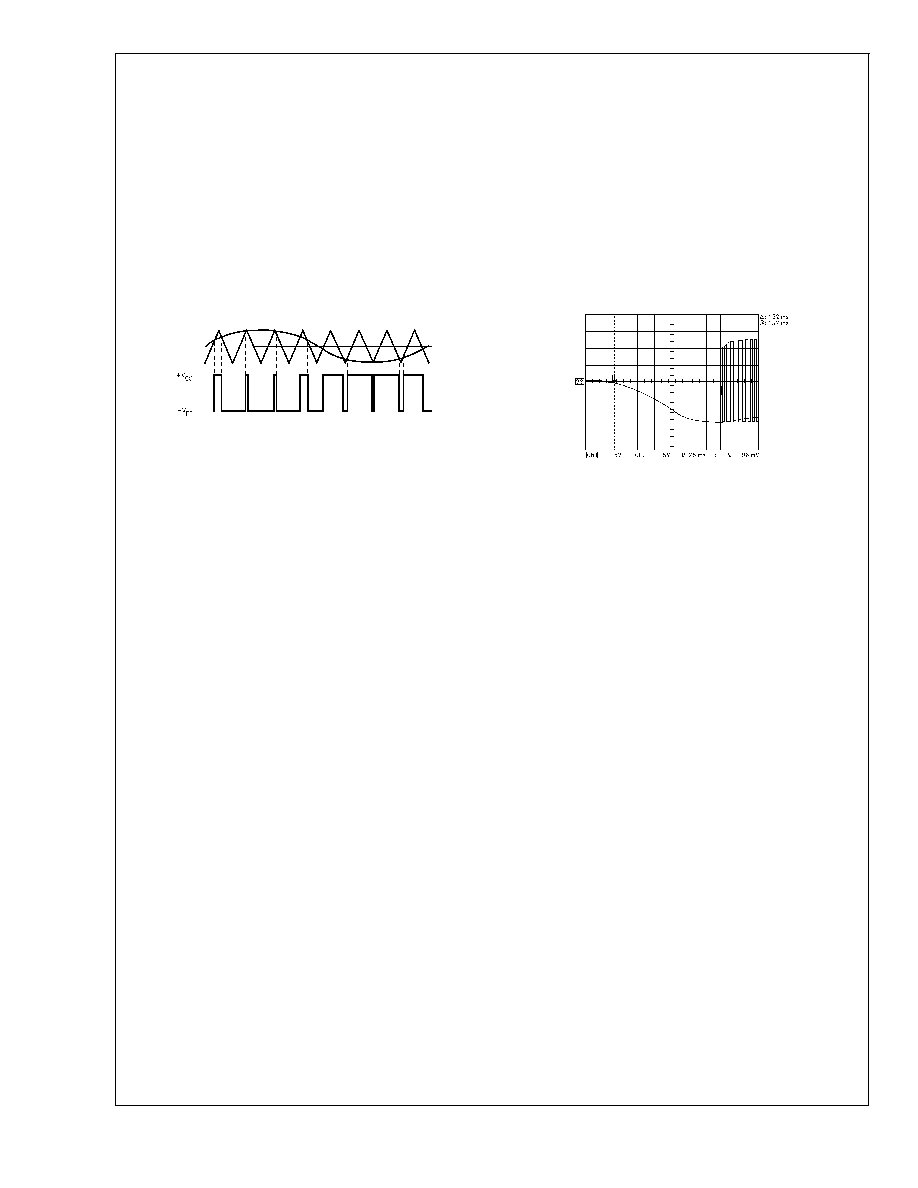
Application Information
GENERAL FEATURES
System Functional Information: The LM4651 is a conven-
tional pulse width modulator/driver. As Figure 2 shows the
incoming audio signal is compared with a triangle waveform
with a much higher frequency than the audio signal (not
drawn to scale). The comparator creates a variable duty
cycle squarewave. The squarewave has a duty cycle propor-
tional to the audio signal level. The squarewave is then
properly conditioned to drive the gates of power MOSFETs in
an H-bridge configuration, such as the LM4652. The pulse
train of the power MOSFETs are then fed into a low pass
filter (usually a LC) which removes the high frequency and
delivers an amplified replica of the audio input signal to the
load.
Standby Function: The standby function of the LM4651 is
CMOS compatible, allowing the user to perform a muting of
the music as well as turning off all power MOSFETs by
shutting down the pulse width waveform. Standby has the
added advantage of minimizing the quiescent current. Be-
cause standby shuts down the pulse width waveform, the
attenuation of the music is complete (
>
120dB), EMI is mini-
mized, and any output noise is eliminated since there is no
modulation waveform. By placing a logic '1' or 5V at pin 13,
the standby function will be enabled. A logic '0' or 0V at pin
13 will disable the standby function allowing modulation by
the input signal.
Under Voltage Protection: The under voltage protection
disables the output driver section of the LM4651 while the
supply voltage is below
±
10.5V. This condition can occur as
power is first applied or when low line, changes in load
resistance or power supply sag occurs. The under voltage
protection ensures that all power MOSFETs are off, eliminat-
ing any shoot-through current and minimizing pops or clicks
during turn-on and turn-off. The under voltage protection
gives the digital logic time to stabilize into known states
providing a popless turn on.
Start Up Sequence and Self-Diagnostic Timing: The
LM4651 has an internal soft start feature (see Figure 3) that
ensures reliable and consistent start-up while minimizing
turn-on thumps or pops. During the start-up cycle the system
is in standby mode. This start-up time is controlled externally
by adjusting the capacitance (C
START
) value connected to
the START pin. The start-up time can be controlled by the
capacitor value connected to the START pin given by Equa-
tion (1) or (2):
t
START
= (8.4x10
4
)C
START
(seconds)
(1)
C
START
= T
START
/(8.5x10
4
)
(Farads)
(2)
The value of C
START
sets the time it takes for the IC to go
though the start-up sequence and the frequency that the
diagnostic circuitry checks to see if an error condition has
been corrected. An Error condition occurs if current limit,
thermal shut down, under voltage detection, or standby are
sensed. The self-diagnostic circuit checks to see if any one
of these error flags has been removed at a frequency set by
the C
START
capacitor. For example, if the value of C
START
is
10µF then the diagnostic circuitry will check approximately
every second to see if an error condition has been corrected.
If the error condition is no longer present, the LM4651/52 will
return to normal operation.
Current Limiting and Short Circuit Protection: The resis-
tor value connected between the SCKT pin and GND deter-
mines the maximum output current. Once the output current
is higher than the set limit, the short circuit protection turns
all power MOSFETs off. The current limit is set to a minimum
of 10A internally but can be increased by adjusting the value
of the R
SCKT
resistor. Equation (3) shows how to find R
SCKT
.
I
SCKT
= 1X10
5
/(10k
\
R
SCKT
)
(Amps)
(3)
This feature is designed to protect the MOSFETs by setting
the maximum output current limit under short circuit condi-
tions. It is designed to be a fail-safe protection when the
output terminals are shorted or a speaker fails and causes a
short circuit condition.
Thermal Protection The LM4651 has internal circuitry (pin
12) that is activated by the thermal shutdown output signal
from the LM4652 (pin 4). The LM4652 has thermal shut
down circuitry that monitors the temperature of the die. The
voltage on the TSD pin (pin 4 of the LM4652) goes high (6V)
once the temperature of the LM4652 die reaches 150∞C.
This pin should be connected directly to the TSD pin of the
LM4651 (pin 12). The LM4651 disables the pulse width
waveform when the LM4652 transmits the thermal shutdown
flag. The pulse width waveform remains disabled until the
TSD flag from the LM4652 goes low, signaling the junction
temperature has cooled to a safe level.
Dead Time Setting The DELAY pin on the LM4651 allows
the user to set the amount of dead time or break before
make of the system. This is the amount of time one pair of
FETs are off before another pair is switched on. Increased
dead time will reduce the shoot through current but has the
disadvantage of increasing THD. The dead time should be
DS101277-1
FIGURE 2. Conventional Pulse Width Modulation
DS101277-70
FIGURE 3. Startup Timing Diagram
LM4651
&
LM4652
www.national.com
10

Application Information
(Continued)
reduced as the desired bandwidth of operation increases.
The dead time can be adjusted with the R
DLY
resistor by
Equation (4):
T
DLY
= 1.7x10
-12
(500 + R
DLY
)
(Seconds)
(4)
Currently, the recommended value is 5k
.
Oscillator Control: The modulation frequency is set by an
external resistor, R
OSC
, connected between pin 16 and
GND. The modulation frequency can be set within the range
of 50kHz to 225kHz according to the design requirements.
The values of R
OSC
and f
OSC
can be found by Equation (5)
and (6):
f
OSC
= 1x10
9
/ (4000 + R
OSC
)
(Hz)
(5)
R
OSC
= (1x10
9
/ f
OSC
) - 4000
(
)
(6)
Equations (5) and (6) are for R
DLY
= 0. Using a value of R
DLY
greater than zero will increase the value needed for R
OSC
.
For R
DLY
= 5k
, R
OSC
will need to be increased by about
2k
. As the graphs show, increasing the switching frequency
will reduce the THD but also decreases the efficiency and
maximum output power level before clipping. Increasing the
switching frequency increases the amount of loss because
switching currents lower the efficiency across the output
power range. A higher switching frequency also lowers the
maximum output power before clipping or the 1% THD point
occur.
Over-Modulation Protection: The over-modulation protec-
tion is an internally generated fixed pulse width signal that
prevents any side of the H-bridge power MOSFETs from
remaining active for an extended period of time. This condi-
tion can result when the input signal amplitude is higher than
the internal triangle waveform. Lack of an over modulation
signal can increase distortion when the amplifier's output is
clipping. Figure 4 shows how the over modulation protection
works.
The over modulation protection also provides a 'soft clip'
type response on the top of a sine wave. This minimum
pulse time is internally set and cannot be adjusted. As the
switching frequency increases this minimum time becomes a
higher percentage of the period (T
PERIOD
= 1/f
SW
). Because
the over modulation protection time is a higher percentage of
the period, the peak output voltage is lower and, therefore,
the output power at clipping is lower for the same given
supply rails and load.
Feedback Amplifier and Filter: The purpose of the feed-
back amplifier is to differentially sample the output and pro-
vide a single-ended feedback signal to the error amplifier to
close the feedback loop. The feedback is taken directly from
the switching output before the demodulating LC filter to
avoid the phase shift caused by the output filter. The signal
fed back is first low pass filtered with a single pole or dual
pole RC filter to remove the switching frequency and its
harmonics. The differential signal, derived from the bridge
output, goes into the high input impedance instrumentation
amplifier that is used as the feedback amplifier. The instru-
mentation amplifier has an internally fixed gain of 1. The use
of an instrumentation amplifier serves two purposes. First,
it's input are high impedance so it doesn't load down the
output stage. Secondly, an IA has excellent common-mode
rejection when its gain setting resistors are properly
matched. This feature allows the IA to derive the true feed-
back signal from the differential output, which aids in improv-
ing the system performance.
Error Amplifier: The purpose of the error amplifier is to sum
the input audio signal with the feedback signal derived from
the output. This inverting amplifier's gain is externally con-
figurable by resistors Rf and R1. The parallel feedback ca-
pacitor and resistor form a low pass filter that limits the
frequency content of the input audio signal and the feedback
signal. The pole of the filter is set by Equation (7).
f
IP
= 1/(2
R
f
C
f
)
(Hz)
(7)
On-Board Regulators: The LM4651 has its own internal
supply regulators for both analog and digital circuits. Sepa-
rate
±
6V regulators exist solely for the analog amplifiers,
oscillator and PWM comparators. A separate voltage regu-
lator powers the digital logic that controls the protection,
level shifting, and high-/low-side driver circuits. System per-
formance is enhanced by bypassing each regulator's output.
The
±
6V regulator outputs, labeled +6V
BYP
(pin 6) and
-6V
BYP
(pin 8) should be bypassed to ground. The digital
regulator output, -V
DDBYP
(pins 20 & 21) should be by-
passed to -V
EE
(pins 22 & 23). The voltage level of -V
DDBYP
should be always be 6V closer to ground than the negative
rail, -V
EE
. As an example, if -V
EE
= -20V, then -V
DDBYP
should equal -14V. Recommended capacitor values and
type can be found in Figure 1, Typical audio Application
Circuit.
APPLICATIONS HINTS
DS101277-2
FIGURE 4. Over Modulation Protection
DS101277-3
FIGURE 5. Feedback instrumentation Amplifier
Schematic
LM4651
&
LM4652
www.national.com
11
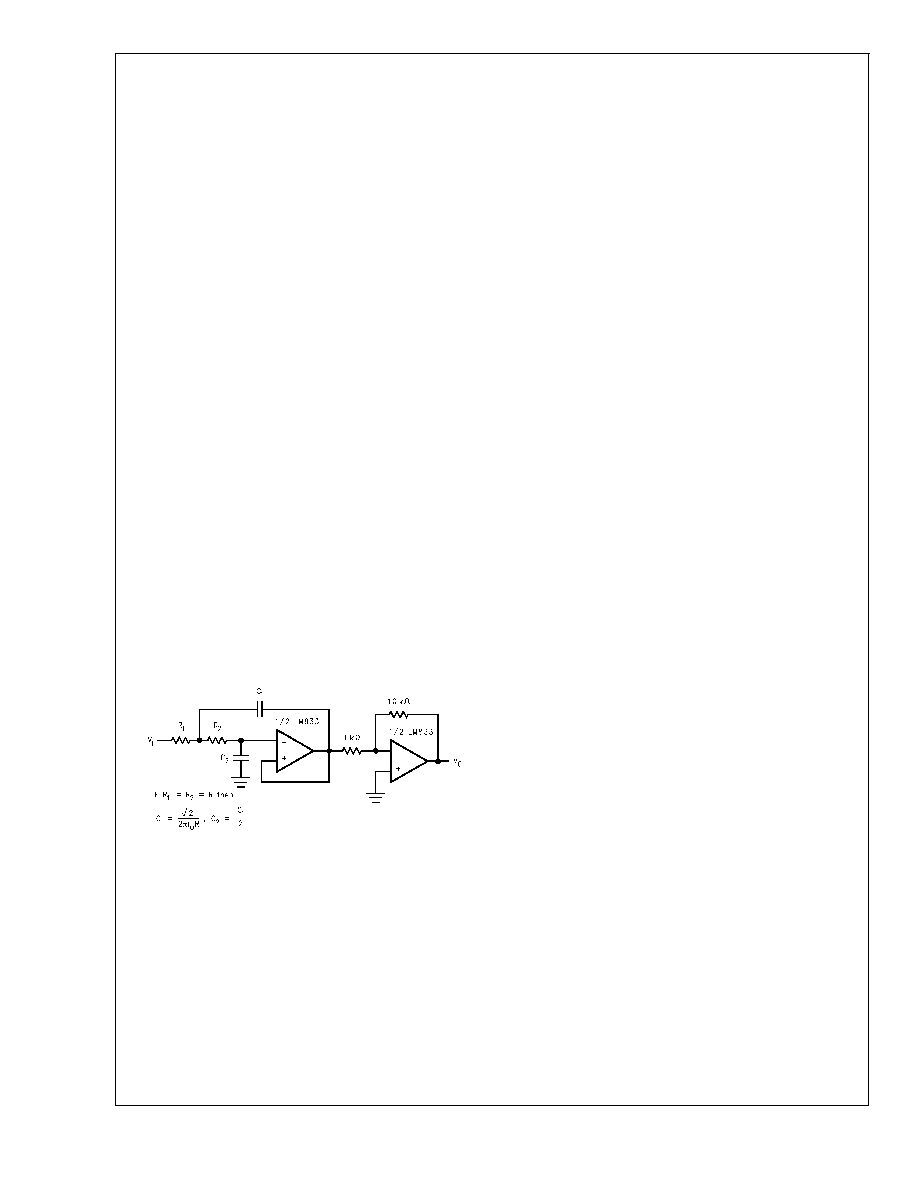
Application Information
(Continued)
Introduction
National Semiconductor (NSC) is committed to providing
application information that assists our customers in obtain-
ing the best performance possible from our products. The
following information is provided in order to support this
commitment. The reader should be aware that the optimiza-
tion of performance was done using a reference PCB de-
signed by NSC and shown in Figure 7 through 11. Variations
in performance can occur because of physical changes in
the printed circuit board and the application. Therefore, the
designer should know that component value changes may
be required in order to optimize performance in a given
application. The values shown in this data sheet can be used
as a starting point for evaluation purposes. When working
with high frequency circuits, good layout practices are also
critical to achieving maximum performance.
Input Pre-Amplifier with Subwoofer Filter
The LM4651 and LM4652 Class D solution is designed for
low frequency audio applications where low gain is required.
This necessitates a pre-amplifier stage with gain and a low
pass audio filter. An inexpensive input stage can be de-
signed using National's LM833 audio operational amplifier
and a minimum number of external components. A gain of 10
(20dB) is recommended for the pre-amplifier stage. For a
subwoofer application, the pole of the low pass filter is
normally set within the range of 60Hz - 180Hz. For a clean
sounding subwoofer the filter should be at least a
second-order filter to sharply roll off the high frequency audio
signals. A higher order filter is recommended for stand-alone
self-powered subwoofer applications. Figure 6 shows a
simple input stage with a gain of 10 and a second-order low
pass filter.
Supply Bypassing
Correct supply bypassing has two important goals. The first
is to ensure that noise on the supply lines does not enter the
circuit and become audible in the output. The second is to
help stabilize an unregulated power supply and provide cur-
rent under heavy current conditions. Because of the two
different goals multiple capacitors of various types and val-
ues are recommended for supply bypassing. For noise
de-coupling, generally small ceramic capacitors (.001µF to
.1µF) along with slightly larger tantalum or electrolytic ca-
pacitors (1µF to 10µF) in parallel will do an adequate job of
removing most noise from the supply rails. These capacitors
should be placed as close as possible to each IC's supply
pin(s) using leads as short as possible. For supply stabiliz-
ing, large electrolytic capacitors (3,300µF to 15,000µF) are
needed. The value used is design and cost dependent.
High Frequency PCB Design
A double-sided PCB is recommended when designing a
class D amplifier system. One side should contain a ground
plane with the power traces on the other side directly over
the ground plane. The advantage is the parasitic capaci-
tance created between the ground plane and the power
planes. This parasitic capacitance is very small (pF) but is
the value needed for coupling high frequency noise to
ground. At high frequencies, capacitors begin to act more
like inductors because of lead and parasitic inductance in the
capacitor. For this reason, bypassing capacitors should be
surface mount because of their low parasitic inductance.
Equation (8) shows how to determine the amount of power to
ground plane capacitance.
C =
e
o
e
rA/d
(Farads)
(8)
where
e
o = 0.22479pF/in and
e
r = 4.1
A is the common PCB area and d is the distance between
the planes. The designer should target a value of 100pF or
greater for both the positive supply to ground capacitance
and negative supply to ground capacitance. Signal traces
that cross over each other should be laid out at 90∞ to
minimized any coupling.
Output Offset Voltage Minimization
The amount of DC offset voltage seen at the output with no
input signal present is already quite good with the LM4651/
52. With no input signal present the system should be at
50% duty cycle. Any deviation from 50% duty cycle creates a
DC offset voltage seen by the load. To completely eliminate
the DC offset, a DC voltage divider can be used at the input
to set the DC offset to near zero. This is accomplished by a
simple resistor divider that applies a small DC voltage to the
input. This forces the duty cycle to 50% when there is no
input signal. The result is a LM4651 and LM4652 system
with near zero DC offset. The divider should be a 1.8M
from the +6V output (pin 6) to the input (other side of 25k,
R
1
). R
1
acts like the second resistor in the divider. Also use
a 1µF input capacitor before R
1
to block the DC voltage from
the source. R
1
and the 1µF capacitor create a high pass filter
with a 3dB point at 6.35Hz. The value of R
OFFSET
is set
according to the application. Variations in switching fre-
quency and supply voltage will change the amount of offset
voltage requiring a different value than stated above. The
value above (1.8M
) is for
±
20V and a switching frequency
of 125kHz.
Output Stage Filtering
As common with Class D amplifier design, there are many
trade-offs associated with different circuit values. The output
stage is not an exception. National has found good results
with a 50µF inductor and a 5µF Mylar capacitor (see Figure
1, Typical Audio Application Circuit) used as the output
LC filter. The two-pole filter contains three components; L
1
and C
BYP
because the LM4651 and LM4652 have a bridged
output. The design formula for a bridge output filter is f
C
=
1/[2
(L
1
2C
BYP
)
1
/
2
].
A common mistake is to connect a large capacitor between
ground and each output. This applies only to single-ended
DS101277-77
FIGURE 6. Pre-amplifier Stage with Low Pass Filter
LM4651
&
LM4652
www.national.com
12

Application Information
(Continued)
applications. In bridge operation, each output sees C
BYP
.
This causes the extra factor of 2 in the formula. The alterna-
tive to C
BYP
is a capacitor connected between each output,
V
O
, and V
O2
, and ground. This alternative is, however, not
size or cost efficient because each capacitor must be twice
C
BYP
's value to achieve the same filter cutoff frequency. The
additional small value capacitors connected between each
output and ground (C
1
) help filter the high frequency from the
output to ground . The recommended value for C
1
is 0.1µF to
1µF or 2% to 20% of C
BYP
.'
Modulation Frequency Optimization
Setting the modulation frequency depends largely on the
application requirements. To maximize efficiency and output
power a lower modulation frequency should be used. The
lower modulation frequency will lower the amount of loss
caused by switching the output MOSFETs increasing the
efficiency a few percent. A lower switching frequency will
also increase the peak output power before clipping because
the over modulation protection time is a smaller percentage
of the total period. Unfortunately, the lower modulation fre-
quency has worse THD+N performance when the output
power is below 10 watts. The recommended switching fre-
quency to balance the THD+N performance, efficiency and
output power is 125kHz to 145kHz.
THD+N Measurements and Out of Audio Band Noise
THD+N (Total Harmonic Distortion plus Noise) is a very
important parameter by which all audio amplifiers are mea-
sured. Often it is shown as a graph where either the output
power or frequency is changed over the operating range. A
very important variable in the measurement of THD+N is the
bandwidth limiting filter at the input of the test equipment.
Class D amplifiers, by design, switch their output power
devices at a much higher frequency than the accepted audio
range (20Hz - 20kHz). Switching the outputs makes the
amplifier much more efficient than a traditional Class A/B
amplifier. Switching the outputs at high frequency also in-
creases the out-of-band noise. Under normal circumstances
this out-of-band noise is significantly reduced by the output
low pass filter. If the low pass filter is not optimized for a
given switching frequency, there can be significant increase
in out-of-band noise.
THD+N measurements can be significantly affected by
out-of-band noise, resulting in a higher than expected
THD+N measurement. To achieve a more accurate mea-
surement of THD, the bandwidth at the input of the test
equipment must be limited. Some common upper filter points
are 22kHz, 30kHz, and 80kHz. The input filter limits the
noise component of the THD+N measurement to a smaller
bandwidth resulting in a more real-world THD+N value.
The output low pass filter does not remove all of the switch-
ing fundamental and harmonics. If the switching frequency
fundamental is in the measurement range of the test equip-
ment, the THD+N measurement will include switching fre-
quency energy not removed by the output filter. Whereas the
switching frequency energy is not audible, it's presence de-
grades the THD+N measurement. Reducing the bandwidth
to 30kHz and 22kHz reveals the true THD performance of
the Class D amplifier. Increasing the switching frequency or
reducing the cutoff frequency of the output filter will also
reduce the level of the switching frequency fundamental and
it's harmonics present at the output. This is caused by a
switching frequency that is higher than the output filter cutoff
frequency and, therefore, more attenuation of the switching
frequency.
In-band noise is higher in switching amplifiers than in linear
amplifiers because of increased noise from the switching
waveform. The majority of noise is out of band (as discussed
above), but there is also an increase of audible noise. The
output filter design (order and location of poles) has a large
effect on the audible noise level. Power supply voltage also
has an effect on noise level. The output filter removes a
certain amount of the switching noise. As the supply in-
creases, the attenuation by the output fiter is constant. How-
ever, the switching waveform is now much larger resulting in
higher noise levels.
THERMAL CONSIDERATIONS
Heat Sinking
The choice of a heat sink for the output FETs in a Class D
audio amplifier is made such that the die temperature does
not exceed T
JMAX
and activate the thermal protection cir-
cuitry under normal operating conditions. The heat sink
should be chosen to dissipate the maximum IC power which
occurs at maximum output power for a given load. Knowing
the maximum output power, the ambient temperature sur-
rounding the device, the load and the switching frequency,
the maximum power dissipation can be calculated. The ad-
ditional parameters needed are the maximum junction tem-
perature and the thermal resistance of the IC package (
JC
,
junction to case), both of which are provided in the Absolute
Maximum Ratings and Operating Ratings sections above.
It should be noted that the idea behind dissipating the power
within the IC is to provide the device with a low resistance to
convection heat transfer such as a heat sink. Convection
cooling heat sinks are available commercially and their
manufacturers should be consulted for ratings. It is always
safer to be conservative in thermal design.
Proper IC mounting is required to minimize the thermal drop
between the package and the heat sink. The heat sink must
also have enough metal under the package to conduct heat
from the center of the package bottom to the fins without
excessive temperature drop. A thermal grease such as
Wakefield type 120 or Thermalloy Thermacote should be
used when mounting the package to the heat sink. Without
some thermal grease, the thermal resistance
CS
(case to
sink) will be no better than 0.5∞C/W, and probably much
worse. With the thermal grease, the thermal resistance will
be 0.2∞C/W or less. It is important to properly torque the
mounting screw. Over tightening the mounting screw will
cause the package to warp and reduce the contact area with
the heat sink. It can also crack the die and cause failure of
the IC. The recommended maximum torque applied to the
mounting screw is 40 inch-lbs. or 3.3 foot-lbs.
Determining Maximum Power Dissipation
Power dissipation within the integrated circuit package is a
very important parameter. An incorrect maximum power dis-
sipation (P
D
) calculation may result in inadequate heat sink-
ing, causing thermal shutdown circuitry to operate intermit-
tently. There are two components of power dissipation in a
class D amplifier. One component of power dissipation in the
LM4651
&
LM4652
www.national.com
13

Application Information
(Continued)
LM4652 is the R
DS(ON)
of the FET times the RMS output
current when operating at maximum output power. The other
component of power dissipation in the LM4652 is the switch-
ing loss. If the output power is high enough and the DC
resistance of the filter coils is not minimized then significant
loss can occur in the output filter. This will not affect the
power dissipation in the LM4652 but should be checked to
be sure that the filter coils with not over heat.
The first step in determining the maximum power dissipation
is finding the maximum output power with a given voltage
and load. Refer to the graph Output Power verses Supply
Voltage to determine the output power for the given load and
supply voltage. From this power, the RMS output current can
be calculated as I
OUTRMS
= SQRT(P
OUT
/R
L
). The power
dissipation caused by the output current is P
DOUT
=
(I
OUTRMS
)
2
*
(2 * R
DS(ON)
). The value for R
DS(ON)
can be
found from the Electrical Characteristics for the LM4652
table above. The percentage of loss due to the switching is
calculated by Equation (9):
%LOSS
SWITCH
= (t
r
+ t
f
+ T
OVERMOD
)
*
f
SW
(9)
t
r
, t
f
and T
OVERMOD
can be found in the Electrical Charac-
teristic for the LM4651 and Electrical Characteristic for
the LM4652 sections above. The system designer deter-
mines the value for f
SW
(switching frequency). Power dissi-
pation caused by switching loss is found by Equation (10).
P
OUTMAX
is the 1% output power for the given supply voltage
and the load impedance being used in the application. P
OUT-
MAX
can be determined from the graph Output Power vs.
Supply Voltage in the Typical Performance Characteris-
tics section above.
P
DSWITCH
= (%LOSS
SWITCH
*
P
OUTMAX
) /
(1-%LOSS
SWITCH
)
(Watts)
(10)
P
DMAX
for the LM4652 is found by adding the two compo-
nents (P
DSWITCH
+ P
DOUT
) of power dissipation together.
Determining the Correct Heat Sink
Once the LM4652's power dissipation known, the maximum
thermal resistance (in ∞C/W) of a heat sink can be calculated.
This calculation is made using Equation (11) and is based on
the fact that thermal heat flow parameters are analogous to
electrical current flow properties.
P
DMAX
= (T
JMAX
- T
AMBIENTMAX
) /
JA
(Watts)
(11)
Where
JA
=
JC
+
CS
+
SA
Since we know
JC
,
CS
, and T
JMAX
from the Absolute
Maximum Ratings and Operating Ratings sections above
(taking care to use the correct
JC
for the LM4652 depending
on which package type is being used in the application) and
have calculated P
DMAX
and T
AMBIENTMAX
, we only need
SA
,
the heat sink's thermal resistance. The following equation is
derived from Equation (11):
SA
= [(T
JMAX
- T
AMBIENTMAX
) / P
DMAX
] -
JC
-
CS
Again, it must be noted that the value of
SA
is dependent
upon the system designer's application and its correspond-
ing parameters as described previously. If the ambient tem-
perature surrounding the audio amplifier is higher than
T
AMBIENTMAX
, then the thermal resistance for the heat sink,
given all other parameters are equal, will need to be lower.
Example Design of a Class D Amplifier
The following is an example of how to design a class D
amplifier system for a power subwoofer application utilizing
the LM4651 and LM4652 to meet the design requirements
listed below:
∑
Output Power, 1% THD
125W
∑
Load Impedance
4
∑
Input Signal level
3V RMS (max)
∑
Input Signal Bandwidth
10Hz - 150Hz
∑
Ambient Temperature
50∞C (max)
Determine the Supply Voltage
From the graph Output Power verses Supply voltage at
1% THD the supply voltage needed for a 125 watt, 4
application is found to be
±
20V.
Determine the Value for R
OSC
(Modulation Frequency)
The oscillation frequency is chosen to obtain a satisfactory
efficiency level while also maintaining a reasonable THD
performance. The modulation frequency can be chosen us-
ing the Clipping Power Point and Efficiency verses
Switching Frequency graph. A modulation frequency of
125kHz is found to be a good middle ground for THD per-
formance and efficiency. The value of the resistor for R
OSC
is
found from Equation (6) to be 3.9 k
.
Determine the Value for R
SCKT
(Circuit Limit)
The current limit is internally set as a failsafe to 10 amps.
The inductor ripple current and the peak output current must
be lower than 10 amps or current limit protection will turn on.
A typical 4
load driven by a filter using 50µH inductors does
not require more than 10A. The current limit will have to be
increased when loads less than 4
are used to acheive
higher output power. With R
SCKT
equal to 100k
, the current
limit is 10A.
Determine the Value for R
DLY
(Dead Time Control)
The delay time or dead time is set to the recommended
value so R
DLY
equals 5k
. If a higher bandwidth of operation
is desired, R
DLY
should be a lower value resistor. If a zero
value for R
DLY
is desired, connect the LM4651's pin 17 to
GND.
Determine the Value of L
1
, C
BYP
, C
1
, R
fl1
R
fl2
, C
fl1
C
fl2
, R
f
,
C
f
(the Output and Feedback Filters)
All component values show in
Figure 1 Typical Audio Ap-
plication Circuit, are optimized for a subwoofer application.
Use the following guidelines when changing any component
values from those shown. The frequency response of the
output filter is controlled by L
1
and C
BYP
. Refer to the Ap-
plication Information section titled Output Stage Filtering
for a detailed explanation on calculating the correct values
for L
1
and C
BYP
.
LM4651
&
LM4652
www.national.com
14

Application Information
(Continued)
C
1
should be in the range of 0.1µF to 1µF or 2 - 20% of C
BYP
.
R
fl1
and R
fl2
are found by the ratio R
fl1
= 10R
fl2
.
A lower ratio can be used if the application is for lower output
voltages than the 125Watt, 4
solution show here.
The feedback RC filter's pole location should be higher than
the output filter pole. The reason for two capacitors in paral-
lel instead of one larger capacitor is to reduce the possible
EMI from the feedback traces. C
fl1
is placed close as pos-
sible to the output of the LM4652 so that an audio signal is
present on the feedback trace instead of a high frequency
square wave. C
fl2
is then placed as close as possible to the
feedback inputs (pins 14, 19) of the LM4651 to filter off any
noise picked up by the feedback traces. The combination
lowers EMI and provides a cleaner audio feedback signal to
the LM4651. R
f
should be in range of 100k
to1M
. C
f
controls the bandwidth of the error signal and should be in
the range of 100pF to 470pF.
Determine the Value for C
START
(Start Up Delay)
The start-up delay is chosen to be 1 second to ensure
minimum pops or clicks when the amplifier is powered up.
Using Equation (2), the value of C
START
is 11.7µF. A standard
value of 10µF is used.
Determine the Value of Gain, R
1
, and R
2
The gain is set to produce a 125W output at no more than
1% distortion with a 3V
RMS
input. A dissipation of 125W in a
4
load requires a 22.4V
RMS
signal. To produce this output
signal, the LM4651/LM4652 amplifier needs an overall
closed-loop gain of 22.4V
RMS
/3V
RMS
, or 7.5V/V (17.5db).
Equation (12) shows all the variables that affect the system
gain.
Gain = [(R
2
/ R
1
) x ((R
fl1
+ R
fl2
)/ R
fl2
) - (R
2
/ R
1
) + .5]. (3)
The values for R
fI1
, R
fI2
, and R
f
were found in the Determine
the Value of the Filters section above. Therefore, R
fI1
=
620k
, R
fI2
= 62k
and R
f
= 390k
. The value of V
CC
was
also found as the first step in this example to be
±
20V.
Inserting these values into equation (12) and reducing gives
the equation below:
R
2
= .7R
1
(4)
The input resistance is desired to be 20k
so R
1
is set to
20k
. R
2
is then found to be 14k
.
Lowering R
2
direcly affects the noise of the system. Chang-
ing R
1
to increase gain with the lower value for R
2
has very
little affect on the noise level. The percent change in noise is
about what whould be expected with a higher gain. The
drawback to a lower R
1
value is a larger C
IN
value, neces-
sary to properly couple the lowest desired signal frequen-
cies. If a 20k
input impedance is not required, then the
recommended values shown in
Figure 1, Typical Audio
Application Circuit should be used: with R
1
's value set to
4.7k
and R
2
's value set to 3.5k
for a gain 7.5V/V.
Determine the Needed Heat Sink
The only remaining design requirement is a thermal design
that prevents activating the thermal protection circuitry. Use
Equations (9) - (11) to calculate the amount of power dissi-
pation for the LM4652. The appropriate heat sink size, or
thermal resistance in ∞C/W, will then be determined.
Equation (9) determines the percentage of loss caused by
the switching. Use the typical values given in the Electrical
Characteristics for the LM4651 and Electrical Character-
istics for the LM4652 tables for the rise time, fall time and
over modulation time:
%Loss = (25ns+26ns+350ns)
*
125kHz
%Loss = 5.0%
This switching loss causes a maximum power dissipation,
using Equation (10), of:
P
DSWITCH
= (5.0%
*
125W) / (1-5.0%)
P
DSWITCH
= 6.6W
Next the power dissipation caused by the R
DS(ON)
of the
output FETs is found by multiplying the output current times
the R
DS(ON)
. Again, the value for R
DS(ON)
is found from the
Electrical Characteristics for the LM4652 table above.
The value for R
DS(ON)
at 100∞C is used since we are calcu-
lating the maximum power dissipation.
I
OUTRMS
= SQRT(125watts/4
) = 5.59 amps
P
RDS(ON)
= (5.59A)
2
*
(0.230
*
2)
P
RDS(ON)
= 14.4W
The total power dissipation in the LM4652 is the sum of
these two power losses giving:
P
DTOTAL
= 6.6W + 14.4W = 21W
The value for Maximum Power Dissipation given in the Sys-
tem Electrical Characteristics for the LM4651 and
LM4652 is 22 watts. The difference is due to approximately
1 watt of power loss in the LM4651. The above calculations
are for the power loss in the LM4652.
Lastly, use Equation (11) to determine the thermal resistance
of the LM4652's heat sink. The values for
JC
and T
JMAX
are
found in the Operating Ratings and the Absolute Maxi-
mum Ratings section above for the LM4652. The value of
JC
is 2∞C/W for the isolated (TF) package or 1∞C/W for the
non-isolated (T) package. The value for T
JMAX
is 150∞C. The
value for
CS
is set to 0.2∞C/W since this is a reasonable
value when thermal grease is used. The maximum ambient
temperature from the design requirements is 50∞. The value
of
SA
for the isolated (TF) package is:
SA
= [(150∞C - 50∞C)/21W] - 2∞C/W - 0.2∞C/W
SA
= 2.5∞C/W
and for the non-isolated (T) package without a mica washer
to isolate the heat sink from the package:
SA
= [(150∞C - 50∞C)/21W] - 1∞C/W - 0.2∞C/W
SA
= 3.5∞C/W
LM4651
&
LM4652
www.national.com
15
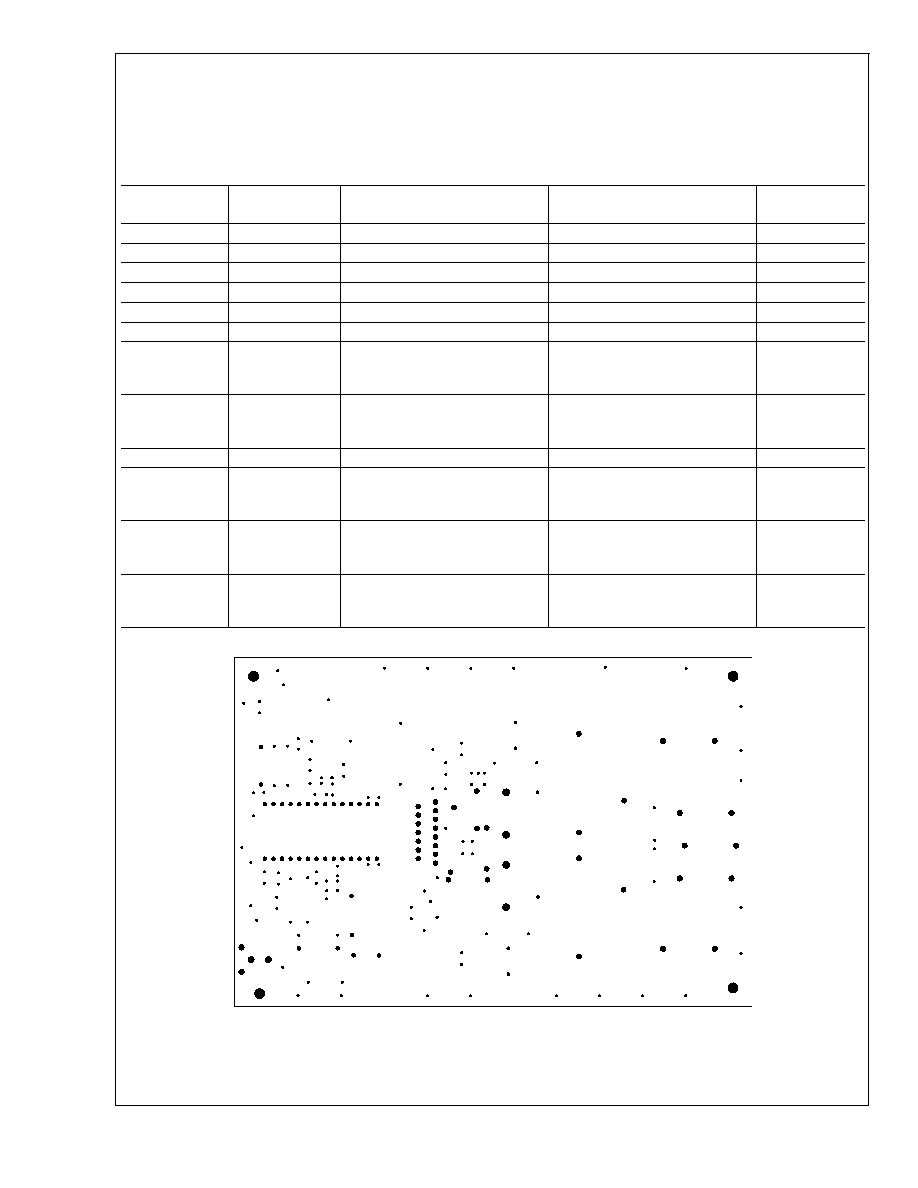
Application Information
(Continued)
To account for the use of a mica washer simply subtract the
thermal resistance of the mica washer from
SA
calculated
above.
Recommendations for Critical External Components
Circuit
Symbol
Suggested
Value
Suggested Type
Supplier/Contact Information
Supplier Part
#
C
fI1
330pF
Ceramic Disc
C
fI2
100pF
Ceramic Disc
C
f
470pF
Ceramic Disc
C
B2
1µF
Resin Dipped Solid Tantalum
C
B1
& C
BT
0.1µF
Monolithic Ceramic
C
B3
0.001µF
Monolithic Ceramic
C
1
& C
BYP
5µF - 10µF
Metalized Polypropylene or
Polyester Film
Bishop Electronics Corp.
(562) 695 - 0446
http://www.bishopelectronics.com/
BEC-9950
A11A-50V
C
1
& C
BYP
5µF - 10µF
Metalized Polypropylene or
Polyester Film
Nichicon Corp.
(847) 843-7500
http://www.nichicon-us.com/
QAF2Exx
or
QAS2Exx
D
1
3A, 50V
Fast Schottky Diode
L
1
47µH, 5A
High Saturation Open Core
(Vertical Mount Power Chokes)
CoilCraft
(847) 639-6400
http://www.coilcraft.com/
PCV-0-
473-05
L
1
50µH, 5.6A
High Saturation Flux Density
Ferrite Rod
J.W. Miller
(310) 515-1720
http://www.jwmiller.com/
5504
L
1
68µH, 7.3A
High Saturation Flux Density
Ferrite Rod
J.W. Miller
(310) 515-1720
http://www.jwmiller.com/
5512
DS101277-29
FIGURE 7. Reference PCB silkscreen layer
LM4651
&
LM4652
www.national.com
16
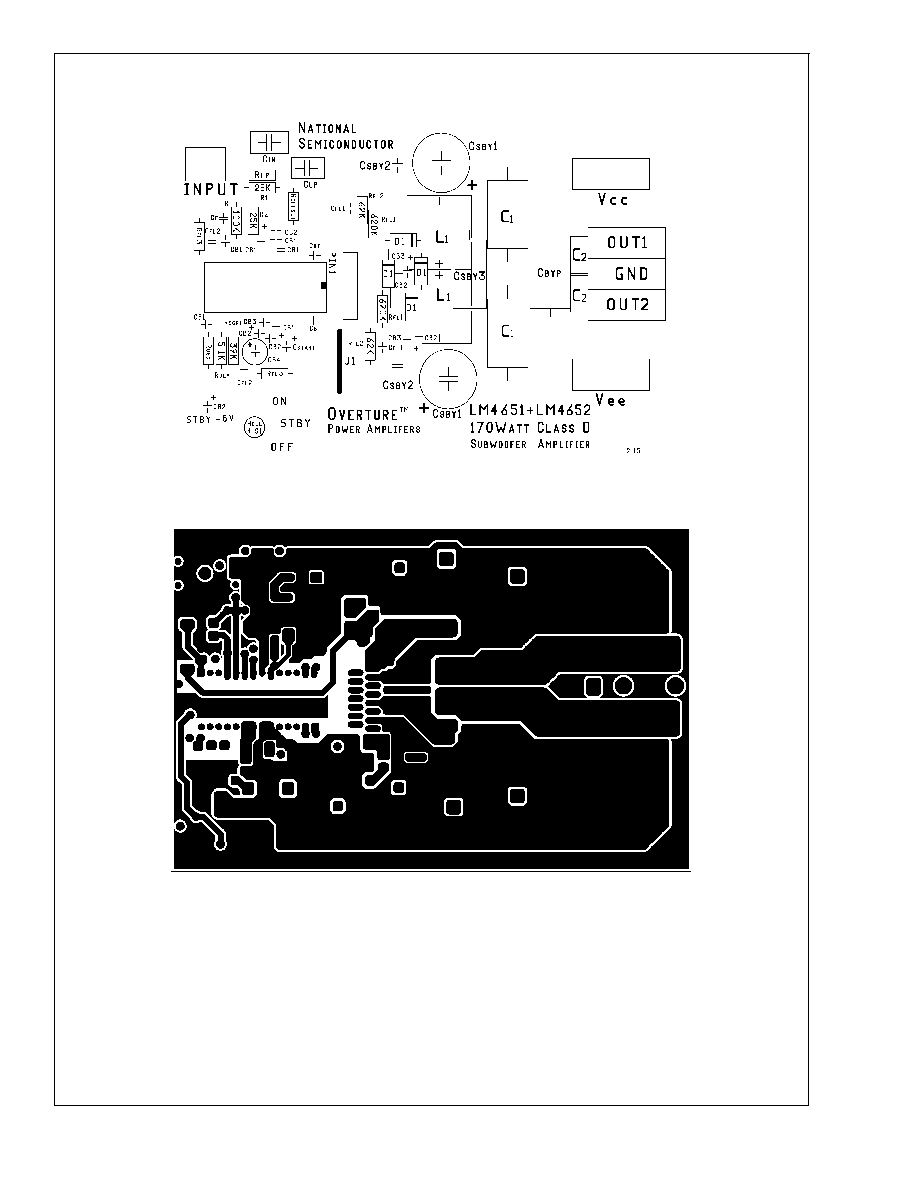
Application Information
(Continued)
DS101277-26
FIGURE 8. Reference PCB top layer
DS101277-27
FIGURE 9. Reference PCB bottom layer
LM4651
&
LM4652
www.national.com
17
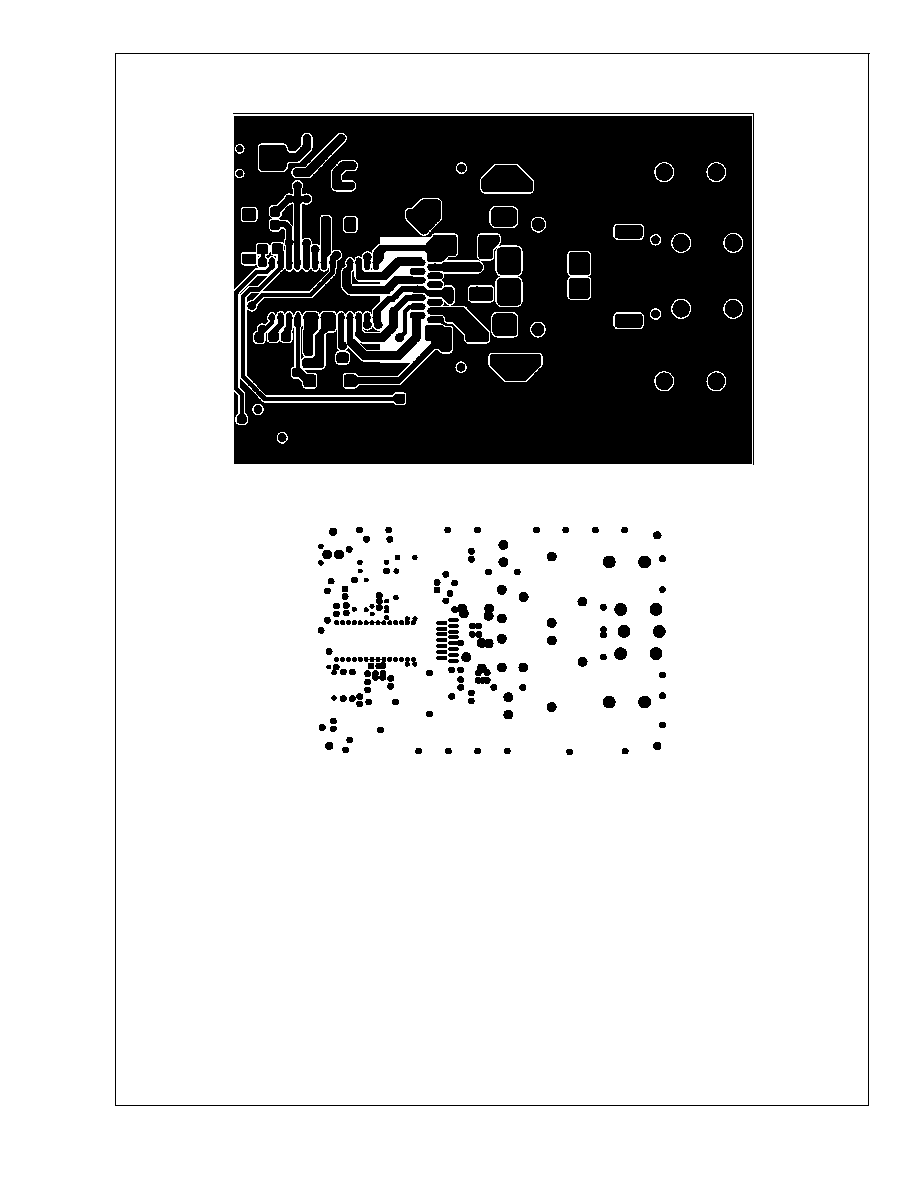
Application Information
(Continued)
DS101277-28
FIGURE 10. Reference PCB top layer solder mask
DS101277-78
FIGURE 11. Reference PCB bottom layer solder mask
LM4651
&
LM4652
www.national.com
18
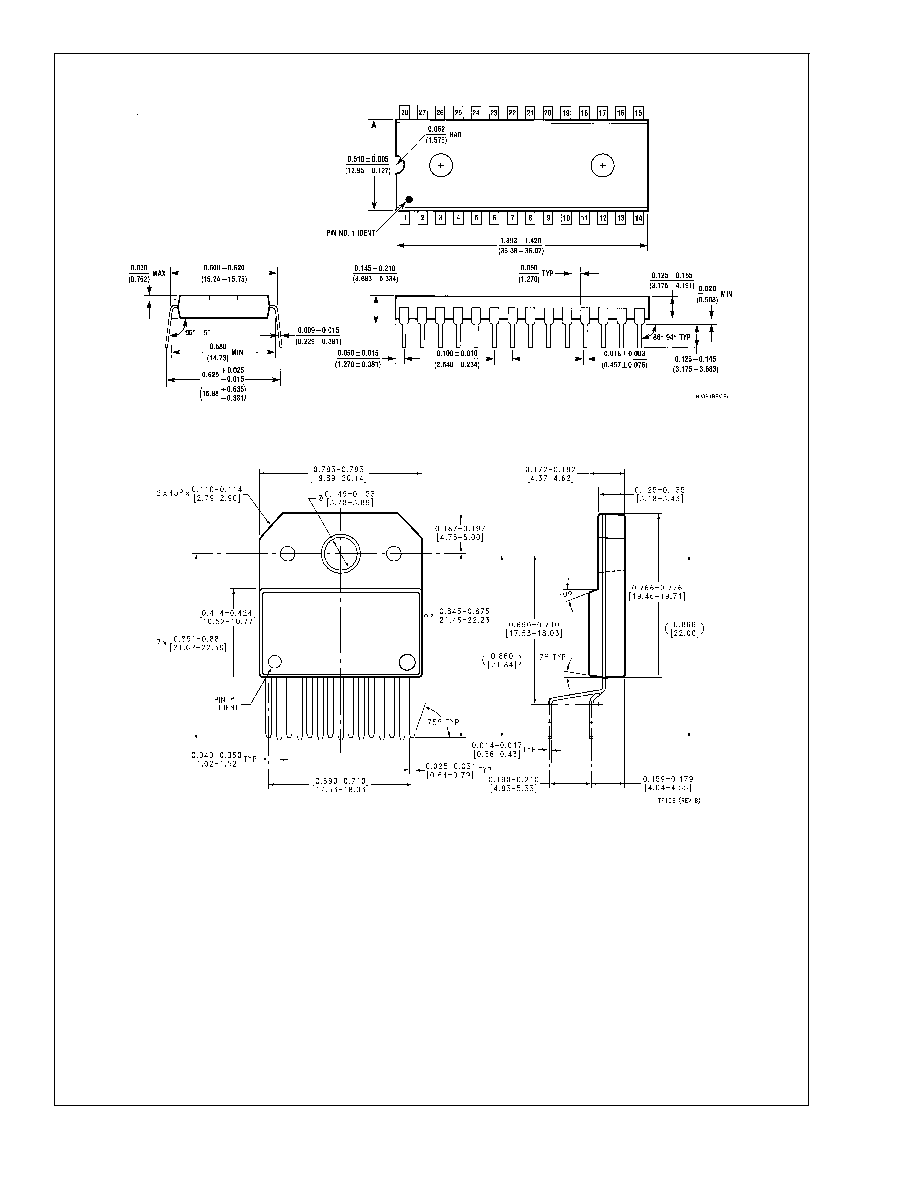
Physical Dimensions
inches (millimeters) unless otherwise noted
Order Number LM4651N
NS Package Number N28B
Order Number LM4652TF
NS Package Number TF15B
LM4651
&
LM4652
www.national.com
19

Notes
LIFE SUPPORT POLICY
NATIONAL'S PRODUCTS ARE NOT AUTHORIZED FOR USE AS CRITICAL COMPONENTS IN LIFE SUPPORT
DEVICES OR SYSTEMS WITHOUT THE EXPRESS WRITTEN APPROVAL OF THE PRESIDENT AND GENERAL
COUNSEL OF NATIONAL SEMICONDUCTOR CORPORATION. As used herein:
1. Life support devices or systems are devices or
systems which, (a) are intended for surgical implant
into the body, or (b) support or sustain life, and
whose failure to perform when properly used in
accordance with instructions for use provided in the
labeling, can be reasonably expected to result in a
significant injury to the user.
2. A critical component is any component of a life
support device or system whose failure to perform
can be reasonably expected to cause the failure of
the life support device or system, or to affect its
safety or effectiveness.
National Semiconductor
Corporation
Americas
Tel: 1-800-272-9959
Fax: 1-800-737-7018
Email: support@nsc.com
National Semiconductor
Europe
Fax: +49 (0) 180-530 85 86
Email: europe.support@nsc.com
Deutsch Tel: +49 (0) 69 9508 6208
English
Tel: +44 (0) 870 24 0 2171
FranÁais Tel: +33 (0) 1 41 91 8790
National Semiconductor
Asia Pacific Customer
Response Group
Tel: 65-2544466
Fax: 65-2504466
Email: ap.support@nsc.com
National Semiconductor
Japan Ltd.
Tel: 81-3-5639-7560
Fax: 81-3-5639-7507
www.national.com
LM4651
&
LM4652
Overture
TM
170W
Class
D
Audio
Power
Amplifier
Solution
National does not assume any responsibility for use of any circuitry described, no circuit patent licenses are implied and National reserves the right at any time without notice to change said circuitry and specifications.



















